Chapter 3 | Geography | 8th Social Science - Components of Hydrologic Cycle | 8th Social Science : Geography : Chapter 3 : Hydrologic Cycle
Chapter: 8th Social Science : Geography : Chapter 3 : Hydrologic Cycle
Components of Hydrologic Cycle
Components of Hydrologic Cycle
There are six main components in hydrologic
cycle. They are:
1) Evapotranspiration,
2) Condensation,
3) Precipitation,
4) Infiltration,
5) Percolation, and
6) Runoff.
1. Evapotranspiration
It is defined as the total loss of
water from the earth through evaporation from the surface water bodies and the
transpiration from vegetation. In cropped area, it is difficult to determine
the evaporation and transpiration separately. Therefore it is collectively
called as evapotranspiration. The following part explains the process of
evaporation and transpiration separately.
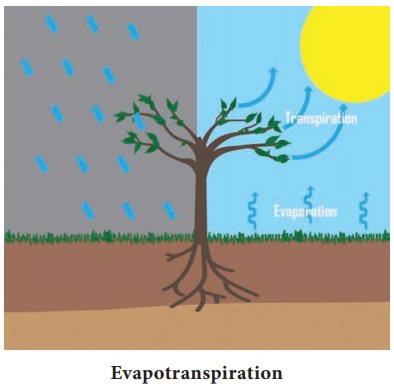
a. Evaporation
Evaporation refers to the process in
which the liquid form of water changes into gaseous form. Water boils at 100°C
(212°F) temperature but, it actually begins to evaporate at 0°C (32°F); and the
process takes place very slowly. Temperature is the prime element which affects
the rate of evaporation. There is a positive relationship between these two
variables. Areal extent of surface water, wind and the atmospheric humidity are
the other variables which affect the rate of evaporation.
The atmosphere gets nearly 90% of
moisture from the oceans, seas, lakes and rivers through evaporation and 10% of
the moisture from plants through transpiration.
On a global scale, the amount of
water gets evaporated is about the same as the amount of water delivered to
earth as precipitation. This process varies geographically, as the evaporation
is more prevalent over the oceans than precipitation, while over the land,
precipitation routinely exceeds evaporation. The rate of evaporation is low
during the periods of calm winds than during windy times. When the air is calm,
evaporated water tends to stay close to the water body. During windy, the water
vapour is driven away and is replaced by dry air which facilitates additional
evaporation.
The rate of evaporation increases with
• Increase in wind
speed
• Increase in
temperature
• Decrease in humidity
and
• Increase in areal
extent of surface water bodies.
b. Transpiration
Transpiration refers to the process
by which the water content in the plants are released into the atmosphere in
the form of water vapour. Much of the water taken up by plants is released
through transpiration. The rate of transpiration is also affected by the
temperature, wind and humidity. The rate of transpiration is also affected by
nature of vegetation and the matheod of cultivation of crops
2. Condensation
It refers to the process in which
the gaseous form of water changes into liquid form. Condensation generally
occurs in the atmosphere when warm air rises, cools and loses its capacity to
hold water vapour. As a result, excess water vapour condenses to form cloud
droplets. Condensation is responsible for the formation of clouds. These clouds
produce precipitation which is the primary route for water to return to the
earth’s surface in the water cycle. Condensation is the opposite of
evaporation.
Forms of Condensation
Dew, frost, fog, mist and clouds are
the different forms of condensation.
a. Dew: It is a water droplet formed by the condensation of water vapour on a
relatively cold surface of an object. It forms when the temperature of an
object drops below the dew point temperature.
b. Frost: The ice crystals formed by deposition of water vapour on a relatively cold surface of an object is known
as frost. It forms when the temperature of an object drops below the freezing
point of temperature.
c. Fog: Fog
is the suspended tiny water droplets
or ice crystals in an air layer next to the earth's surface that reduces the
visibility to 1,000 m or lower. For aviation purposes, the criterion for fog is
10 km or less.
d. Mist: Mist is the tiny droplets of water hanging in the air. These droplets
form when the water vapour in the air is rapidly cooled, causing it to change
from invisible gas to tiny visible water droplets. Mist is less dense than fog.
e. Clouds: Clouds consist of tiny water droplets/ice particles which are so small and light in weight.
Clouds are formed by microscopic drops of water or by small ice crystals. The
size of the droplets generally range from a couple of microns to 100 microns.
When the size of the water droplets exceeds 100 microns, it becomes rain drops.
• Condensation occurs
when the air get saturated.
• Warm air can hold
more water vapour than the cool air.
• Saturation occurs
when the temperature drops down.
3. Precipitation
Precipitation refers to all forms of
water that fall from clouds and reaches the earth’s surface. For the occurrence
of precipitation, cloud droplets or ice crystals must grow heavy enough to fall
through the air. When the droplets grow large in size, they tend to fall. While
moving down, by collecting some small droplets, they become heavy enough to
fall out of the cloud as raindrops.
Forms of Precipitation
The form of precipitation in a
region depends on the kind of weather or the climate of the region. The precipitation
in the warmer parts of the world is always in the form of rain or drizzle. In
colder regions, precipitation may fall as snow or ice. Common types of
precipitation are rain, sleet, freezing rain, hail and snow.
Rain:
The most common kind of precipitation is rain. The precipitation in the form of
water droplets is called rain. The precipitation in which the size of rain
drops are <0.5 mm in diameter is known as drizzle and the rain drops with
>0.5 mm in diameter is known as rain. Generally drizzle takes place from
stratus clouds.
Sleet: The
precipitation which takes place in
the form of mixture of water droplets and tiny particles of ice(5mm in
diameter) is known as sleet. Sometimes raindrops fall through a layer of air
below 0°C, the freezing point of water. As they fall, the raindrops freeze into
solid particles of ice. So, the mixture of water droplets and ice particles
would fall on the earth surface.
Freezing Rain: Some times raindrops falling
through cold air near the ground do not freeze in the air. Instead, the
raindrops freeze when they touch a cold surface. This is called freezing rain
and the drops of water are usually greater than 0.5 mm in diameter.
Hail: The
precipitation which consists of round
pellets of ice which are larger than 5 in diameter is called hail or
hailstones. Hail forms only in cumulonimbus clouds during thunderstorms. A
hailstone starts as an ice pellet inside a cold region of a cloud. Strong
updrafts in the cloud carry the hailstone up and down through the cold region
many times.
Snow: Often
water vapour in a cloud is converted
directly into snow pieces due to lowering of temperature. It appears like a
powdery mass of ice. The precipitation in the form of powdery mass of ice is
known as snowfall. It is common in the polar and high mountainous regions.
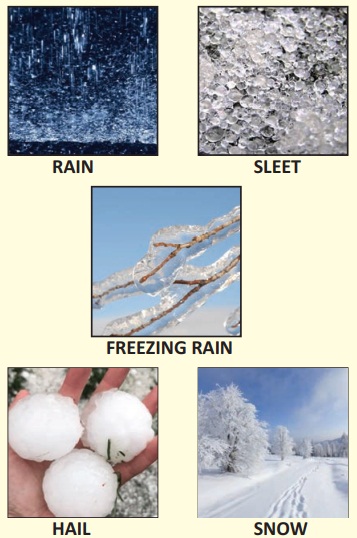
4. Infiltration
Water entering the soil at the
surface of the ground is termed as infiltration. Infiltration allows the soil
temporarily to store water, making it available for plants use and organisms in
the soil. Infiltration is an important process where rain water soaks into the
ground, through the soil and underlying rock layers. Some of this water
ultimately returns to the surface through springs or low spots down hills. Some
of the water remains underground and is called groundwater. The rate of
infiltration is influenced by the physical characteristics of the soil,
vegetative cover, moisture content of the soil, soil temperature and rainfall
intensity. The terms infiltration and percolation are often used
interchangeably.
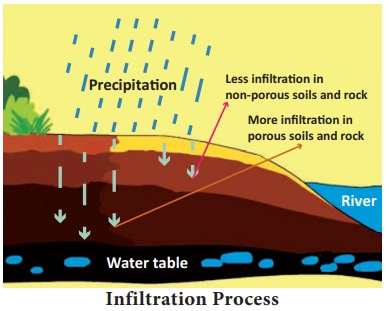
5. Percolation
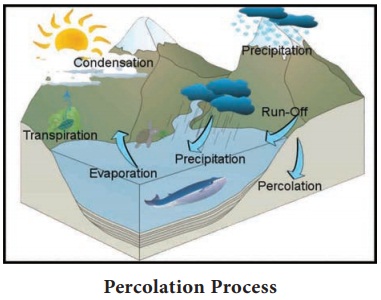
Percolation is the downward movement
of infiltrated water through soil and rock layers. Infiltration occurs near the
surface of the soil and delivers water from the surface into the soil and plant
root zones. Percolation moves the infiltrated water through the soil profile
and rock layers which leads to the formation of ground water or become a part
of sub-surface run -off process.
Thus, the percolation process
represents the flow of water from unsaturated zone to the saturated zone.
6. Runoff
Runoff is the water that is pulled
by gravity across land’s surface. It replenishes groundwater and surface water
as it percolates into an aquifer (it is an underground layer of water-bearing
rock) or moves into a river, stream or watershed. It comes from unabsorbed
water from rain, snowmelt, irrigation or other sources, comprising a
significant element in the water cycle as well as the water supply when it
drains into a watershed.
Runoff is also a major contributor
to the erosion which carves out canyons, gorges and related landforms. The rate
of runoff that can happen depends on the amount of rainfall, porosity of soil,
vegetation and slope. Only about 35% of precipitation ends up in the sea or
ocean and the other 65% is absorbed into the soil.
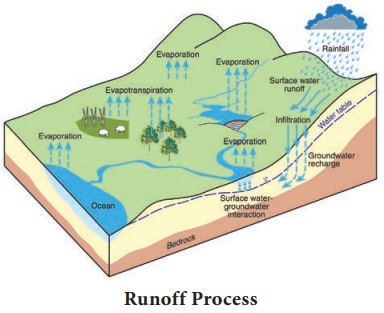
Types of Runoff
Based on the time interval between
the instance of rainfall and generation of runoff, the runoff may be classified
into following three types
i. Surface Runoff: It is the portion of rainfall, which enters the stream
immediately after the rainfall. It occurs, when the rainfall is longer, heavier
and exceeds the rate of infiltration. In this condition the excess water makes
a head over the ground surface, which tends to move from one place to another
following land gradient and is known as overland flow. When the overland flow
joins the streams, channels or oceans, it is termed as surface runoff or
surface flow.
ii. Sub-Surface Runoff: The water that has entered
the subsoil and moves laterally without joining the water-table to the streams,
rivers or oceans is known as sub- surface runoff. The sub-surface runoff is
usually referred as interflow.
iii. Base Flow: It is a flow of underground water from a saturated ground water zone to a water channel. It
usually appears at a downstream location where the channel elevation is lower
than the groundwater table. Groundwater provides the stream flow during dry
periods of small or no precipitation.
Units of the Measurement pertaining to
Hydrology
* Evaporation
/interception - inches (or) cm
* Infiltration -
inches (or) cm / hour
* Precipitation -
inches (or) mm ( or) cm
* Run off - inches
(or) mm (or) cm
* Run off rate - cubic
feet per second
* Run off volume -
acre feet (or) cubic feet
* Storage - cubic feet
(or) acre feet
Related Topics